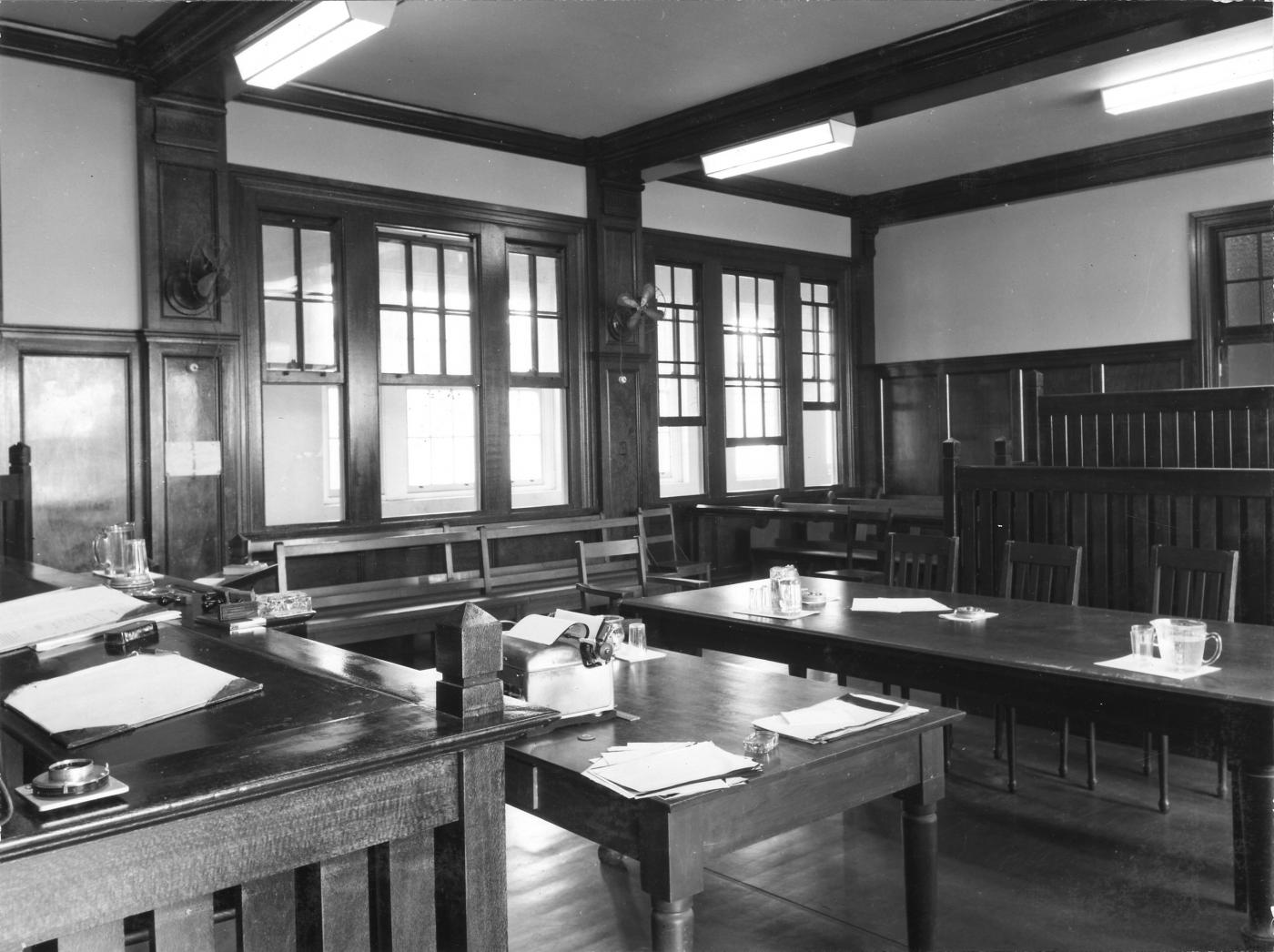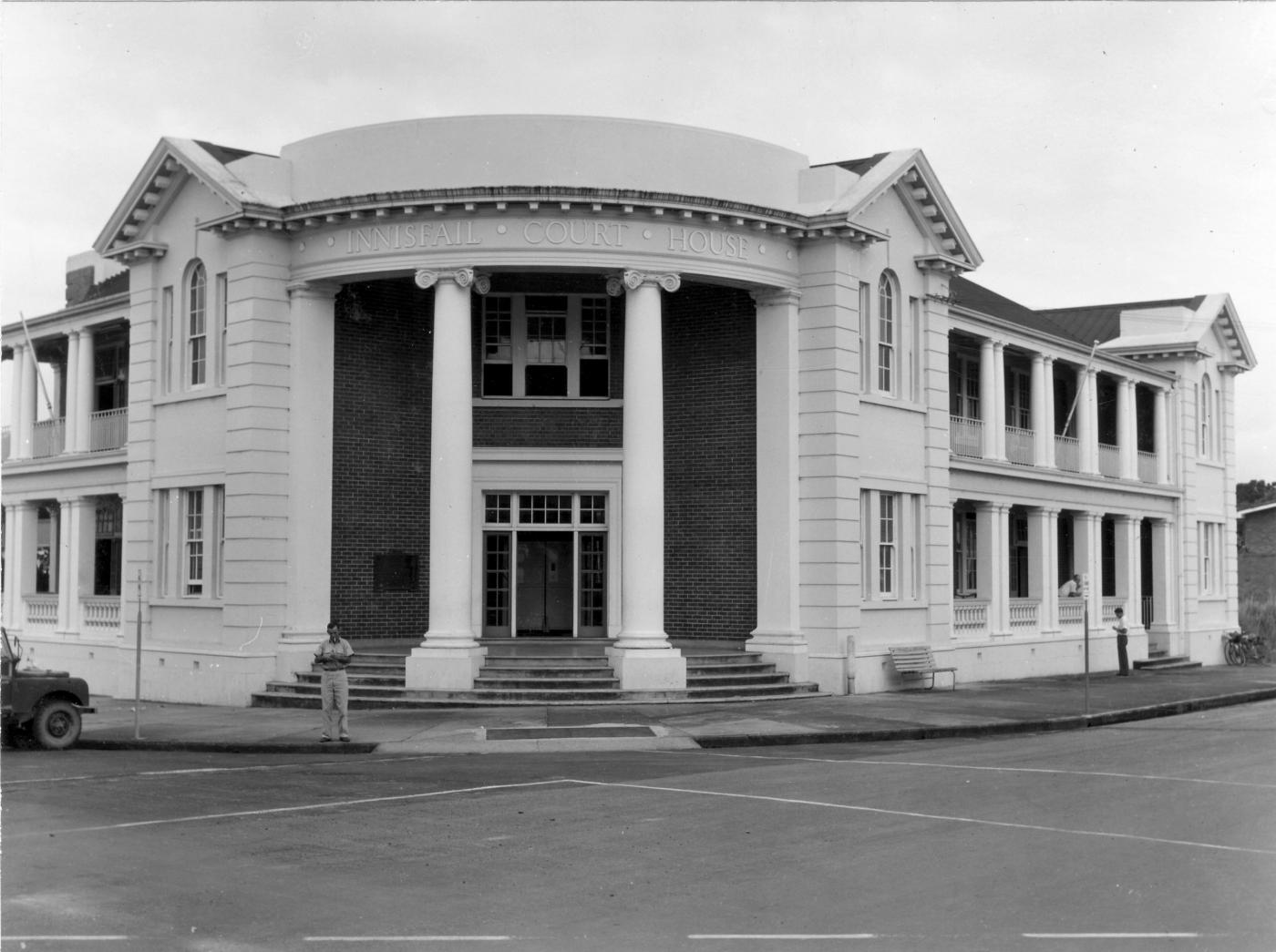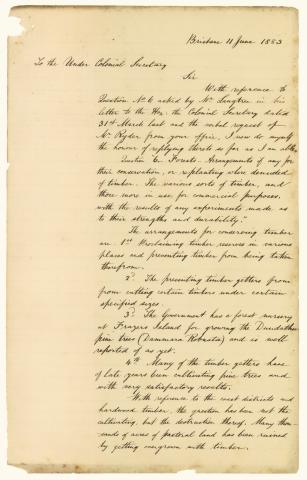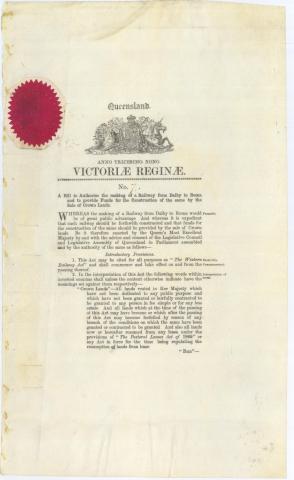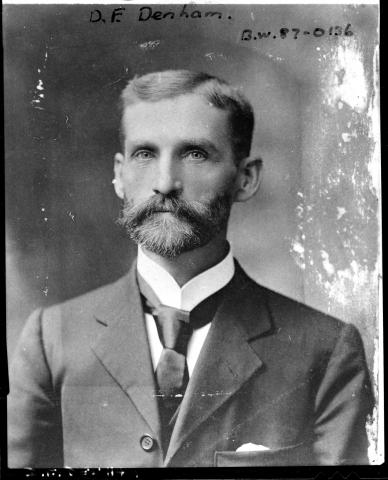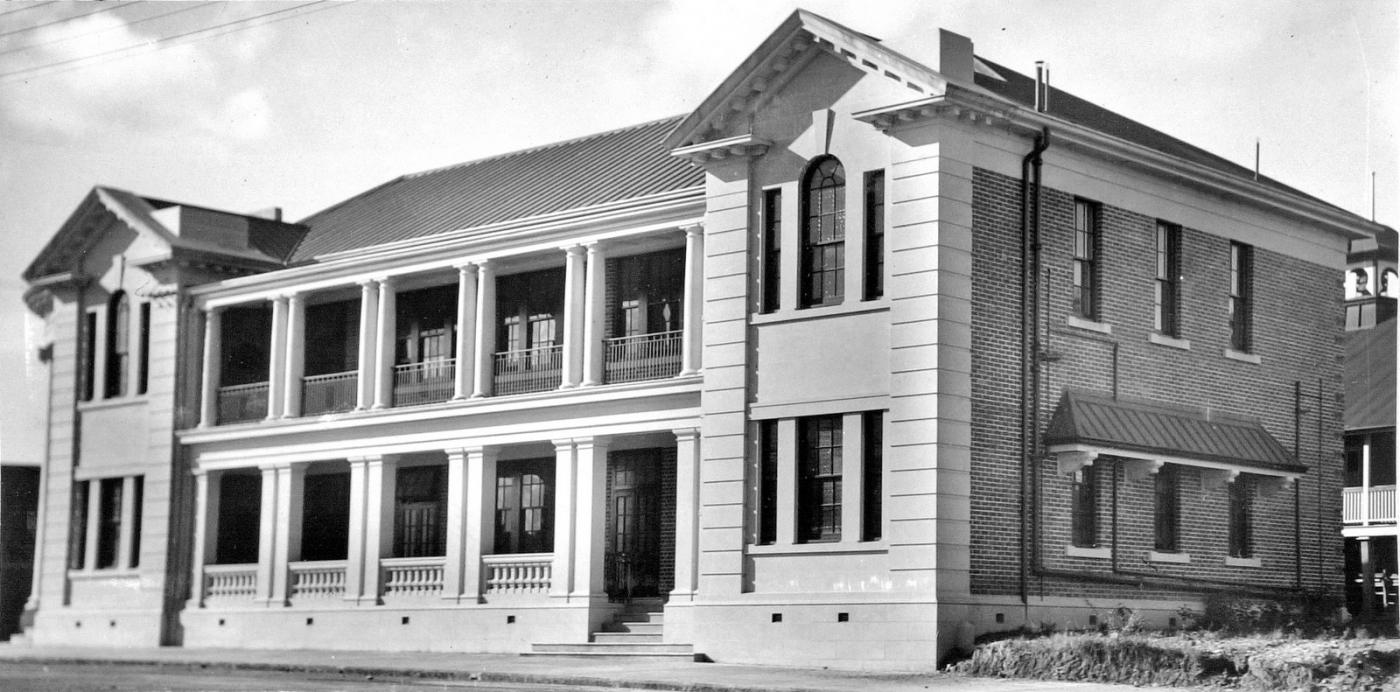
- News of the day
-
Cairns Post (Qld. : 1909 - 1954), Monday 4 March 1940, page 5
Innisfail Court House Official Opening by Minister for Lands 4 March 1940
Contrary to yesterday’s expectations, due to the flood state of portion of the country in the north, the Minister for Lands (Mr P Pease) and party managed to reach Townsville by utilising pump car, boat and rail motor, and thence came on to Innisfail by train, arriving here at 5 o’clock this morning. Mr and Mrs Pease and members of the ministerial party received a hearty welcome.
The official opening of the new court house, which it was thought would have to be deferred, was carried out to time, and at 9.30 there was a large gathering in front of the ornate building, which is situation on the corner of Rankin and Edith streets, to witness what was a very interesting ceremony.
THE BUILDING
A description of the building, which was supplied by Mr Pease to a representative of ‘The Cairns Post,’ is as follows:-
“The new court house, which is replacing the existing building, occupies a corner position on the site of the present structure (which has been removed to an adjoining site to accommodate the Police Department). The new building has been planned to give adequate accommodation for the various departments concerned, with special attention to light and ventilation. The elections have been treated in a renaissance manner, featuring a main corner entrance, which is semi-circular in plan with full height well proportioned Ionic columns and entablature flanked on either side, with rusticated and ashlar lined plastered walls, and colonnaded verandahs with contrasting face-brick walls behind. The building consists of two floors. The ground floor has a large panelled entrance hall, leading off which are two corridors (connecting to the CPS and Lands Department offices) and the main staircase to the first floor. The first floor has been devoted to the Justice Department, with a court room 35 feet by 27 feet, witnesses’ rooms, and also rooms for the Police Magistrate and visiting officials. Verandahs and lavatory accommodation have been provided on both floors, as well as water and electric light services. The main entrance hall, staircases, front verandahs and lavatories to both floor, and corridors on the ground floor have concrete floors; otherwise the floors are of selected hardwood. The wings on either side of the main portico to Edith and Rankin streets are 50 feet 6 inches by 48 feet respectively.”
MINISTER WELCOMED.
“We are gathered together for the pleasant task of welcoming Mr Pease to open the new court house,” said Mr C Burchill, PM, when introducing the Member for Herbert. “As you are aware,” continued the speaker, “ Mr Pease was one of those primarily responsible for the erection of this beautiful building. I think the citizens of Innisfail and district are able represented by Mr Pease, who does everything possible in his power for his constituents. I have pleasure in asking Mr Pease to open the new building, and also thank him and other members of the Government for erecting such a magnificent place to the use to the public service, also for the use of the public of Innisfail. I trust they will make due use ot the bottom part of the building, and not too much use of the top part (the court room). (Laughter.) I also have pleasure in handing Mr Pease the key of a room which is being set aside for his use, to receive deputations, etc., in connection with his department. The room is on the top floor. I am also presenting Mr Pease a memorial key for the official opening of the building, this being to commemorate the important function which is taking place.”
SPEECH BY MR PEASE
Mr Pease said that he usually made most of his speeches at election time, as people could then answer him back, which they generally did. In his party Mr J D O’Hagan (under-Secretary for Justice) and Mr Hope (Under-Secretary of the Treasury) and they had had quite an interesting experience in getting to Innisfail.
“I understand,” continued Mr Pease, “some Innisfail people who yesterday saw the tablet on this building announcing that I was going to open the new court house in March 2, wondered who was going to alter the date. (Smiles.) As Member for Herbert I can never let my people down. When I am due here I come. That is my job as your member. I desire to pay a tribute to Mr O’Hagan and Mr Hope for braving the elements and dangers we experienced in getting here. Mr O’Hagan is the official head of the Justice Department, and more important still, Mr Hope is the man who controls the Treasury of Queensland. I saw to it that he was here on this tour because we have not finished considering considerable development in this district, and I want to see the Treasury realise what they are getting for the money they are spending. We travelled by train as far as Ayr, thence by rail motor, pump car and boat, catching a train at Townsville and arriving at 5 o’clock this morning. So that date of the official opening of the new building is still March 2.
THE COST
“So far as the new building is concerned,’ Proceeded Mr Pease, “it cost £21,500, and you local residents will not have to pay any increased rates in respect of that. (Smiles.) Thanks to good handling of the finances of Queensland by the Premier and Treasury Department, you will be called upon to pay any increased taxation because Queensland is one State of Australia where, despite the immense amount of money expended, we have not increased taxation. I want to give credit to Mr J D Story, who, unfortunately, is not present today. As Public Service Commissioner, Mr Story was responsible for recommending to the Government where money can be wisely spent in providing facilities for the people. He always realised that everything should be done for an important town like Innisfail. You see the new court house today and the greatest credit for this type of building is really due to Mr Story. He did not design the place: that was done by architects of the Public Works Department, and I want to pay a tribute to the men in charge of the work (Mr A H Martin and the men under him). The place did not exceed the estimate. Every man pulled his weigh and gave good service. Mr Story got the idea of this building from the Customs House in Townsville. The Public Works Department architects took a line from that structure, and erected a similar one for Innisfail. There is only one feature of the building which Mr Story did not approve. His idea was that it should be on an elevation with nicely terraced garden plots. Why this building was brought to the ground level was because the Johnstone shire Council required filling material to make the streets, and the Department of Public Words was good enough to give to the local authority, for the benefit of the people of Innisfail, the filling from the elevation. That is why the new court house has been brought to the street level.
“What pleases me more than anything else,” remarked Mr Pease, “is that there is practically all Queensland timber in this building. One great feature which is not the case in Brisbane, is the casements of the various windows are of North Queensland silky oak, whereas in Brisbane the bulk of the buildings, state and Federal, have the casements made from maple from other States of Australia. Everyone knows that the Innisfail district has developed from the sugar industry, but I foresee the time when this district will get a tremendous revenue from its timber resources. I congratulate the Johnstone shire Council on the wonderful town hall they have erected. I may say that during the last election campaign I received many complaints from my constituents that this shire building cost too much money, and that the ratepayers would have to bear an increased burden by way of rates. The Government gave £16,000 by way of subsidy for that town hall, so that the general taxpayers of Queensland really subsidise the beautiful structure to the extent of £16,000. Although the ratepayers of the town and district shoulder the balance you hold the record of having a shire hall second only to the million pound Town Hall in Brisbane. I give credit to the business people for the buildings they are erecting in Innisfail. I notice among this audience some friends of mine of 20 years: think of the buildings then, and those here today, and you must pay a tribute to the people who realised the wonderful future this district had, and who were good enough to put their money into buildings in a town like Innisfail. The progress of this district since I have been your member has been wonderful, and we have had the co-operation of the business people and workers alike.”
Mr Pease then handed Mr Burchill views of Mourilyan Harbour 20 years ago, and of the same place today, the comparison being amazing.
The building was officially declared open by the Minister, who threw wide the front doors, and an inspection of the place was made by the public.
Important officials present at the function ere Mr Fallen (Department of Public Works, Cairns) and Mr A H Martin (foreman).
- Background
-
Opened in March 1940, this was the third court house to be built in Innisfail, replacing a timber building erected in 1888. The building was designed in the office of the Department of Public Works; AB Leven was the Chief Architect at the time.
The Johnstone River area was settled by cedar-cutters, with the first major planting of sugar cane by occurring in 1880. TH Fitzgerald is generally credited with planting the first sugar cane, and was responsible for the erection of the first mill in the area, late in 1881. Also in 1881, a town was laid out at the junction of the South Johnstone and North Johnstone Rivers, known reputedly as the Junction. The name Geraldton was given to the town in 1883.
Geraldton's first official building was erected c1881, probably on the police reserve, accommodated a Police Station, Court House, Unofficial Post Office, Lands Office, Customs Office, an office for the Clerk of Petty Sessions and a gaol. Tenders for a new court house was called in late 1887, and plans for the building indicate the location of the building as on the corner of the police reserve bounded by Edith and Rankin Streets.
The name of the town was changed to Innisfail in 1910. By the late 1900s-early 1910s, the Innisfail district was attracting attention from both land speculators and settlers. The Queensland Government had expressed its intention of opening up the Mourilyan Harbour, and of resuming and extending the local tramline inland from the coast, giving further impetus to the development of the district.
Innisfail was devastated by a record flood in 1913, then by a cyclone in 1918, which destroyed many of the town's timber buildings. Despite these setbacks, the town prospered and opened its third sugar mill in 1916. Soldier settlement was established in Johnstone Shire around 1918, and in 1922, a number of blocks were made available to returned soldiers for growing sugar cane. Completion of the railway from Brisbane to Cairns in 1924, gave further impetus to the development of the district. By the 1920s, the Innisfail sugar industry was producing vast quantities of sugar cane and record yields of sugar, and the prosperity thisbought to the town was reflected in the many substantial buildings erected in the twenties and thirties. These include important civic buildings such as the first wing of the hospital, the Roman Catholic Church, the Commonwealth Bank and other commercial premises. Also important in the town's development were the opening of the Jubilee Bridge in 1923, linking the town with East Innisfail and Mourilyan, and the Dardgee Railway Bridge in 1924.
Although consideration was given to the likely need for expanded court house facilities to cope with an increasing amount of official and legal business, it was not until 1937 that plans for the erection of a new court house were drawn up, including the erection of a new two-storeyed brick court house on the site of the timber court house, and relocation of the timber court house to the east of the new court house, for use as the Police office and barracks.
During the 1930s Depression, Labor Premier William Forgan Smith established a government initiated works scheme under the Income (Unemployment Relief) Act (1930) to create employment. This involved the employment of architects, foremen, labourers and the use of local materials in the design and construction of government buildings such as court houses, government offices and state schools. The Innisfail and Mackay court houses are two fine examples of the substantial brick buildings erected through this work scheme.
The new building was completed in late 1939. Offices for a number of Government Departments were provided on the ground floor, with the court room and court facilities located on the first floor of the building. Minor alterations have been undertaken to the building in recent years, including the addition of a small air conditioning enclosure at the south east end of the court house.
Courtesy of the Queensland Heritage Register
Additional images
/146.0313902,-17.524664,7/450x450@2x.png?access_token=pk.eyJ1IjoicXNhLWRpc2NvLXFsZCIsImEiOiJjamJmdTgyZXEyeWNjMnlxZm8xcmtieHgxIn0.lmT9J5tTPKGuuccQgCVSAg)

